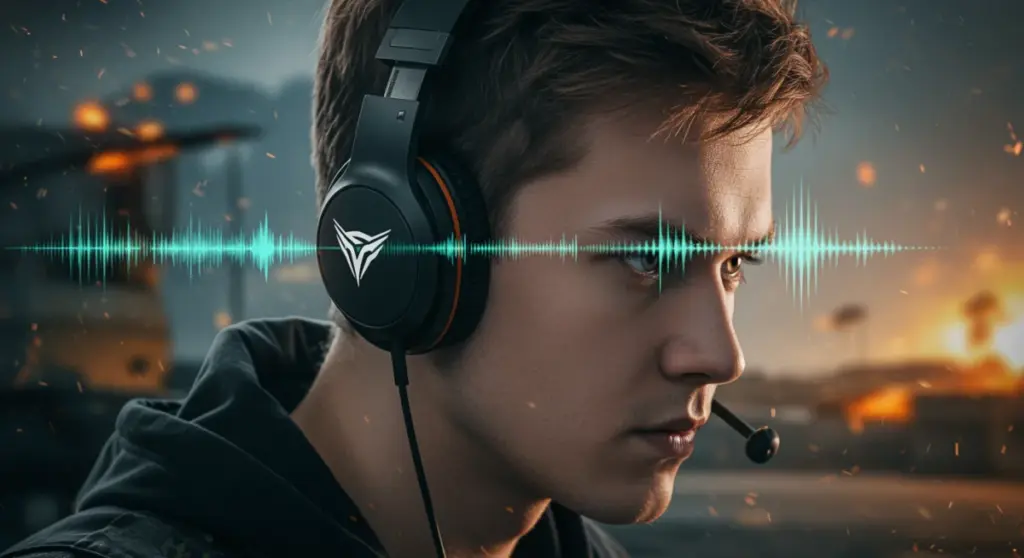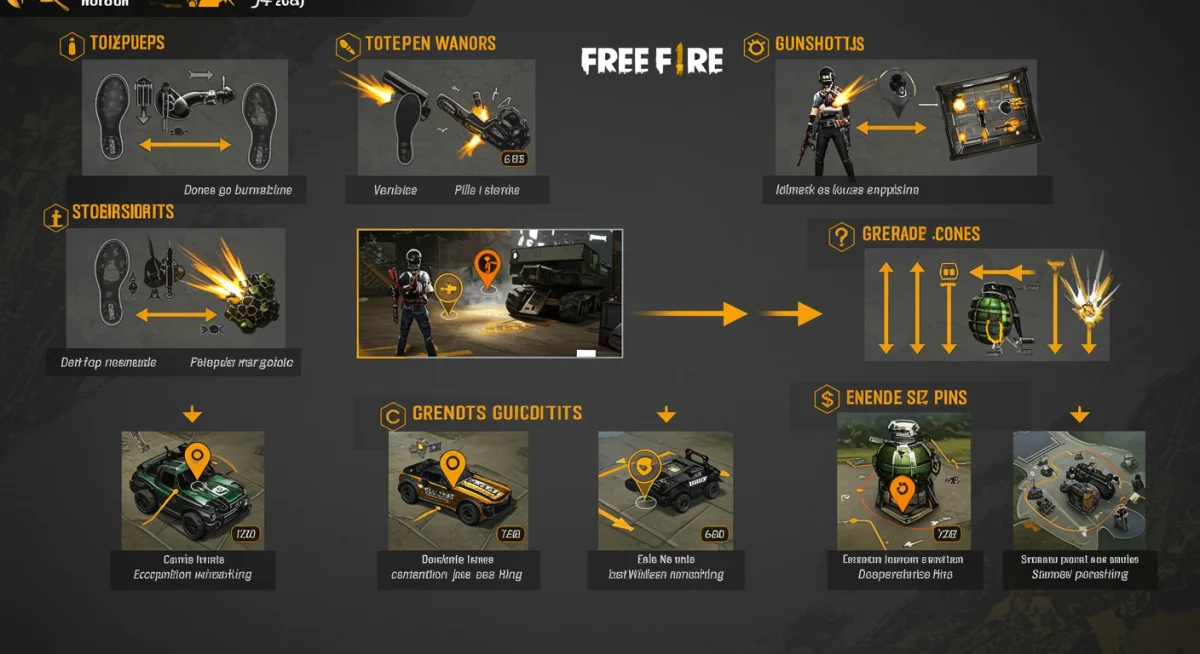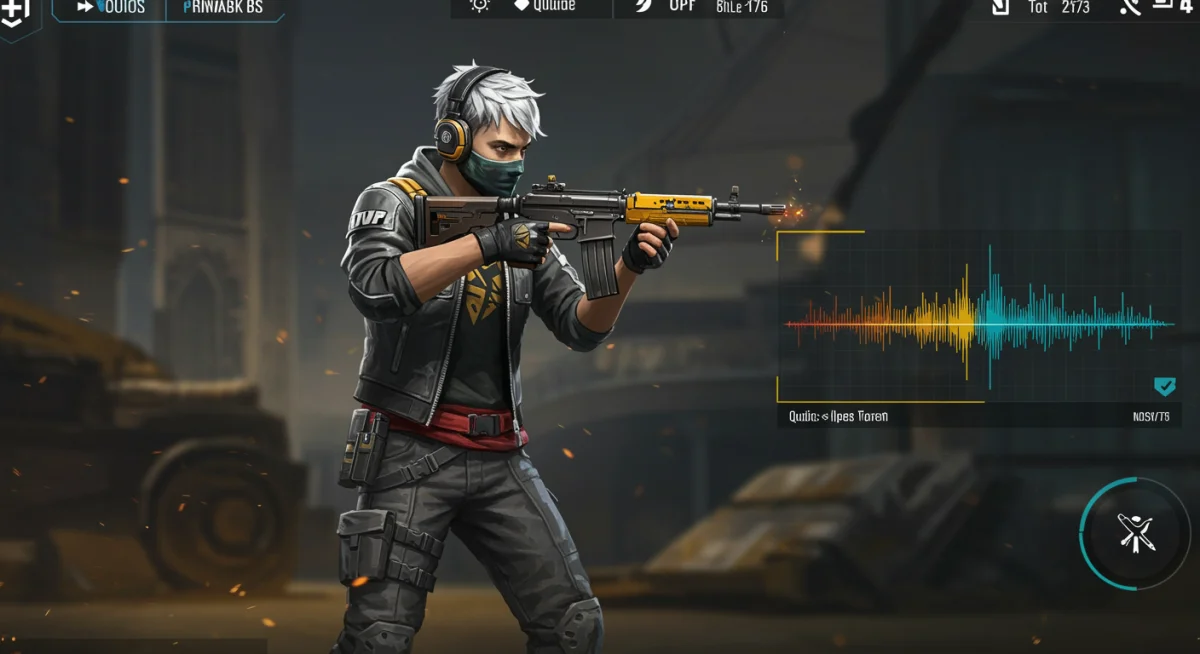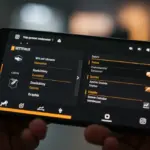Free Fire Sound Strategies: Master Audio Cues for Tactical Wins

Anúncios
Mastering Free Fire sound strategies is crucial for detecting enemies, understanding their movements, and gaining a significant tactical advantage, ultimately leading to more victories in intense matches.
In the high-stakes world of Free Fire, where every second counts and survival is paramount, understanding and utilizing Free Fire Sound Strategies can be the decisive factor between victory and defeat. Far beyond just visual information, audio cues provide a rich layer of tactical intelligence, allowing players to detect unseen threats, anticipate enemy movements, and position themselves for the perfect ambush or escape. This guide will delve deep into how mastering the soundscape of Free Fire can elevate your gameplay, transforming you from a reactive player into a proactive strategist who dominates the battlefield.
The foundational role of sound in Free Fire
Sound in Free Fire isn’t merely background noise; it’s a critical, often underestimated, source of information that directly impacts your tactical decisions. From the subtle rustle of footsteps to the distinct crack of a distant sniper rifle, every audio cue tells a story about the battlefield. Recognizing and interpreting these sounds effectively allows players to build a mental map of enemy positions and intentions, even when they are out of sight.
This auditory awareness acts as a sixth sense, providing an edge that visual information alone cannot. Players who prioritize sound often find themselves outmaneuvering opponents, setting up ambushes, or making timely retreats. It’s a skill that, once honed, becomes an invaluable asset in every match.
Understanding different sound types
- Footsteps: These are perhaps the most vital audio cues, indicating an enemy’s proximity and direction. Different terrains produce distinct footstep sounds, which can further refine your understanding of their location.
- Gunshots: Each weapon in Free Fire has a unique sound signature. Learning these can help identify the type of weapon an enemy is using, informing your engagement strategy. Directional sound helps pinpoint the shooter’s general location.
- Vehicle Sounds: The roar of an approaching vehicle signals an enemy’s rapid movement. Recognizing the direction and speed of the vehicle can help you prepare for an interception or take cover.
- Grenade Pins/Explosions: The distinct sound of a grenade being primed or its subsequent explosion alerts you to danger, giving you precious moments to react and minimize damage.
The ability to differentiate between these sounds quickly and accurately is a hallmark of skilled Free Fire players. It’s about more than just hearing; it’s about active listening and immediate interpretation. As you gain experience, these sounds will become second nature, guiding your strategic choices.
Ultimately, sound is a silent informant, constantly updating you on the evolving battlefield. Ignoring it is akin to fighting with one eye closed; embracing it opens up a world of tactical possibilities that can significantly boost your performance and survivability in Free Fire. Developing a keen ear is a continuous process, but the rewards are substantial.
Optimizing your audio setup for Free Fire
Having a good audio setup is the first and most crucial step in leveraging Free Fire sound strategies. Even the most skilled player will struggle to interpret audio cues if their equipment isn’t up to par. Investing in quality gear and configuring your in-game settings correctly can dramatically enhance your ability to hear and react to critical sounds.
subpar setup might muffle crucial details, making it difficult to distinguish between distant footsteps and environmental ambient noise. Conversely, a well-optimized setup ensures clarity, directional accuracy, and the ability to pick out subtle sounds that betray enemy positions.
Choosing the right headphones
High-quality stereo headphones are non-negotiable for serious Free Fire players. While surround sound might seem appealing, stereo often provides better directional accuracy for in-game audio, as most game engines are optimized for stereo output. Look for headphones with a wide frequency response and clear sound separation.
- Comfort: Long gaming sessions demand comfortable headphones. Look for lightweight designs with breathable earcups.
- Sound Isolation: Good passive noise isolation helps block out real-world distractions, allowing you to focus solely on in-game audio.
- Microphone Quality: While not directly related to hearing enemies, a clear microphone is essential for effective communication with your squad, which is another tactical layer.
Beyond the hardware, maintaining your headphones is also important. Ensure they are clean and free from damage, as even minor issues can degrade sound quality. Regularly checking your audio drivers on PC or device settings on mobile can prevent unexpected issues.
Properly positioning your headphones is also key. Ensure they sit snugly over your ears, providing a good seal for optimal sound delivery and noise isolation. A loose fit can lead to sound leakage and reduced clarity, diminishing your ability to pinpoint enemy locations accurately.
In-game audio settings and their impact
Free Fire offers various audio settings that players can adjust to fine-tune their auditory experience. These settings, often overlooked, can make a significant difference in how effectively you perceive and react to in-game sounds. Experimenting with them is vital to find what works best for you.
The default settings are often a compromise, designed to suit a broad audience. However, for competitive play, a personalized audio profile can provide a distinct advantage. Understanding what each setting does empowers you to tailor the soundscape to your tactical needs, emphasizing critical cues while minimizing less important ones.
Adjusting sound levels strategically
The main sound settings typically include master volume, music volume, sound effects (SFX) volume, and voice chat volume. For optimal tactical play, certain adjustments are recommended:
- Master Volume: Set this to a comfortable but high level, ensuring all sounds are audible without being overwhelming.
- Music Volume: Turn this down or off completely. Music, while atmospheric, can mask crucial enemy movement sounds or gunshots.
- SFX Volume: Maximize this setting. SFX includes footsteps, gunshots, grenade sounds, and vehicle noises – all critical for tactical awareness.
- Voice Chat Volume: Adjust this based on your squad’s communication style. Ensure it’s loud enough to hear calls but not so loud that it drowns out SFX.
Some players also experiment with equalizer settings if their device or headphones support it, boosting frequencies where footsteps or specific weapon sounds reside. However, this requires a bit of technical knowledge and careful adjustment to avoid distorting other important sounds.
Beyond these, maintaining a quiet real-world environment is equally important. External noise can easily interfere with your ability to hear subtle in-game cues, negating the benefits of even the best audio setup and settings. Creating a dedicated gaming space free from distractions is a part of optimizing your audio strategy.

Mastering directional audio and sound visualization
Directional audio is perhaps the most powerful aspect of Free Fire sound strategies. The ability to not only hear a sound but also accurately determine its origin point allows players to pinpoint enemy locations without visual contact. This skill is crucial for pre-firing around corners, anticipating flanks, and avoiding ambushes.
Many modern games, including Free Fire, employ advanced spatial audio techniques to simulate realistic sound propagation. This means a gunshot fired to your left will sound predominantly in your left ear, while footsteps approaching from behind will be heard from the rear. Training your ears to interpret these subtle directional cues is a game-changer.
Interpreting sound direction
The key to mastering directional audio lies in consistent practice and active listening. Pay attention to how sounds shift as you turn your character or as enemies move around you. Early on, you might only be able to tell if a sound is generally to your left, right, front, or back. With practice, you’ll start to discern more precise angles and distances.
- Headphone Orientation: Always ensure your headphones are worn correctly (left ear cup on left ear, right on right). Incorrect orientation will reverse directional cues, leading to confusion.
- Sound Fade: The loudness of a sound often correlates with distance. Fading sounds usually mean an enemy is moving away, while increasing loudness suggests they’re getting closer.
- Sound Occlusion: Sounds can be muffled or blocked by obstacles like walls or buildings. Understanding how these affect sound can provide clues about enemy positions within structures.
Another helpful tool in Free Fire is the visual sound indicator, often appearing as small arrows or arcs on your screen, pointing in the direction of significant sound events like gunshots or footsteps. While these are a great aid, relying solely on them can make you less attuned to the more subtle audio cues that might not trigger a visual indicator. Use them as a supplement, not a replacement, for active listening.
Regularly practicing in different game modes, focusing specifically on listening, will gradually improve your directional audio perception. Try playing a few matches with your screen minimized or blurred, forcing yourself to rely almost entirely on sound to navigate and track enemies. This extreme exercise can rapidly enhance your auditory awareness.
Advanced sound tactics and counter-strategies
Once you’ve mastered the basics of hearing and interpreting sounds, you can start employing more advanced Free Fire Sound Strategies. These tactics involve not just listening, but also understanding how your own sounds affect enemies and how to manipulate the soundscape to your advantage. It’s about turning audio into an offensive and defensive weapon.
Advanced players don’t just react to sounds; they create them strategically. This might involve making intentional noise to draw enemies into a trap, or moving silently to execute a stealthy flank. Every action, whether a reload, a jump, or a sprint, has an auditory footprint that can be exploited or concealed.
Using sound to bait and ambush
One effective advanced tactic is to use your own sounds to bait enemies. Firing a few shots into the air, or deliberately making noise while moving, can attract curious opponents. Once they commit to investigating the sound, you can position yourself for an easy ambush. This works particularly well in areas with good cover and clear lines of sight to the sound’s origin point.
- Fake Grenades: Sometimes, the sound of pulling a grenade pin is enough to make enemies panic and move, revealing their position. You don’t even need to throw it.
- Vehicle Decoys: Drive a vehicle close to an enemy position and then abandon it, moving silently on foot to flank them as they focus on the vehicle’s last known location.
- Strategic Reloads: Reloading loudly at a corner might make an enemy push, thinking you’re vulnerable. Be ready to counter-attack as they approach.
Conversely, understanding how to minimize your own sound is equally important. Walking instead of sprinting, avoiding unnecessary jumps, and using suppressors on weapons are all ways to reduce your auditory footprint. This allows for stealthy approaches, unexpected flanks, and successful escapes when outnumbered.
Paying attention to the timing of your actions relative to environmental sounds can also provide camouflage. For example, moving during an air-drop sound or a distant vehicle passing can mask your footsteps, making it harder for enemies to detect your approach. This requires careful observation and a quick understanding of the game’s dynamic sound events.

Training your ears and developing sound awareness
Developing superior sound awareness in Free Fire isn’t an innate talent; it’s a skill cultivated through deliberate practice and focused attention. Just like aiming or movement, your auditory perception can be trained and refined over time. The more you consciously listen and interpret, the better you become at it.
Many players tend to rely heavily on visual cues, often missing out on the wealth of information provided by sound. Shifting your focus to actively listening requires a conscious effort, especially in fast-paced engagements. However, the benefits of this enhanced awareness are profound, offering insights that visuals alone cannot.
Practice exercises for sound training
Integrate specific sound-focused exercises into your Free Fire training routine:
- “Blind” Playthroughs: Play a few casual matches with your screen brightness very low or even with your eyes closed for short periods (in a safe, non-competitive environment, of course). This forces you to rely almost entirely on sound for navigation and enemy detection.
- Sound-Focused VOD Reviews: Re-watch your own gameplay recordings, paying specific attention to the audio. Identify moments where you missed an audio cue that could have altered the outcome of an engagement. Analyze how pro players react to sounds.
- Listen for Details: During matches, make a conscious effort to identify specific sounds. Can you tell the difference between an M4A1 and an AK47 by sound alone? Can you differentiate between footsteps on grass versus concrete?
Another effective method is to engage in custom room battles with friends, where you specifically practice sound-based tracking. One player moves around, making various noises (walking, sprinting, shooting), while the other tries to pinpoint their location purely by sound. This controlled environment allows for focused practice without the pressure of a full match.
Consistency is key. Make sound awareness a habit in every match you play. Over time, your brain will naturally start to process and interpret these audio cues more efficiently, turning active listening into an almost instinctive reaction. This continuous improvement will solidify your position as a tactically superior player in Free Fire.
Integrating sound into overall tactical gameplay
Ultimately, sound strategies are not isolated techniques; they are an integral part of a comprehensive tactical approach to Free Fire. Merging your auditory intelligence with map awareness, movement, and shooting mechanics creates a synergy that elevates your overall gameplay. It’s about using all available information to make the most informed decisions.
A player who understands the map, moves effectively, aims accurately, and also possesses superior sound awareness is a formidable opponent. Sound becomes a layer that enhances every other aspect of your game, providing context and foresight that can turn the tide of battle.
Combining sound with visual and map information
The most effective players seamlessly combine audio cues with visual information and their understanding of the map. For instance, hearing footsteps to your left might immediately prompt you to check the mini-map for potential flanking routes or common enemy positions in that direction. This cross-referencing of information significantly reduces uncertainty.
- Pre-aiming: If you hear footsteps approaching a corner, you can pre-aim your crosshair at head-level before they even appear, giving you a crucial first-shot advantage.
- Rotational Decisions: Sounds of distant engagements can inform your rotation path – whether to engage, avoid, or third-party. If you hear a firefight, you can strategically move towards it to catch weakened opponents.
- Looting Efficiency: Identifying enemy positions via sound can guide your looting strategy, helping you avoid hot zones or move towards areas where enemies have recently left, leaving behind valuable loot.
Effective communication within your squad also plays a vital role. Calling out enemy footsteps, gunshots, or vehicle movements with precise directional information allows your teammates to react accordingly, turning individual sound awareness into a collective tactical advantage. Using terms like “footsteps, left, close” or “shots, far, northeast” can be incredibly impactful.
By consistently integrating sound into every facet of your gameplay, you develop a holistic understanding of the battlefield. This allows for more intelligent pushes, safer retreats, and more successful engagements, solidifying your position as a top-tier Free Fire player. Sound is not just an add-on; it’s a core component of high-level play.
| Key Strategy | Brief Description |
|---|---|
| Optimize Audio Setup | Invest in quality stereo headphones and adjust in-game settings to maximize SFX and minimize music for clearer sound cues. |
| Master Directional Audio | Train your ears to accurately pinpoint enemy locations based on sound origin, using headphone orientation and sound fading. |
| Utilize Sound as Bait | Intentionally make noise (e.g., fake shots, vehicle sounds) to draw enemies into ambushes or reveal their positions. |
| Minimize Your Own Sound | Move silently by walking, avoiding unnecessary actions, and using suppressors to execute stealthy flanks and avoid detection. |
Frequently Asked Questions About Free Fire Sound Strategies
Sound strategies are crucial because they provide vital information about enemy positions, movements, and intentions that visual cues alone cannot. This auditory intelligence allows players to anticipate threats, plan ambushes, and make informed tactical decisions, significantly increasing their chances of survival and victory in intense Free Fire matches.
For Free Fire, high-quality stereo headphones with good sound isolation are recommended. Stereo often provides better directional accuracy for in-game sounds. It’s also essential to adjust in-game audio settings, prioritizing sound effects (SFX) volume over music and master volume, to ensure critical cues like footsteps and gunshots are clearly audible.
Improving directional audio perception requires practice. Consciously focus on listening for sound origins during gameplay. Practice exercises like “blind” playthroughs (relying solely on sound for navigation) or reviewing gameplay recordings to identify missed audio cues can help. Ensure your headphones are worn correctly for accurate left/right sound.
Yes, advanced players often use sound as a tactical tool to trick enemies. This can include firing a few shots to bait opponents into revealing their position, using vehicle sounds as a decoy, or even strategically reloading loudly at a corner to make enemies push, allowing you to set up an ambush. It’s about manipulating the soundscape.
The most important sounds to listen for in Free Fire are footsteps, gunshots, and vehicle noises. Footsteps indicate immediate enemy proximity and direction, gunshots reveal ongoing engagements and weapon types, and vehicle sounds signal rapid enemy movement. Grenade pin pulls and explosions are also crucial for avoiding damage and identifying enemy actions.
Conclusion
Mastering Free Fire Sound Strategies is not just an optional skill; it’s a fundamental aspect of high-level gameplay that separates average players from true tacticians. By optimizing your audio setup, actively training your ears to discern directional cues, and strategically manipulating the soundscape, you unlock a powerful layer of information that enhances every decision you make on the battlefield. Embrace the power of sound, and you’ll find yourself not only detecting enemies with greater precision but also gaining a significant, consistent tactical advantage that leads to more victories and a richer Free Fire experience.





